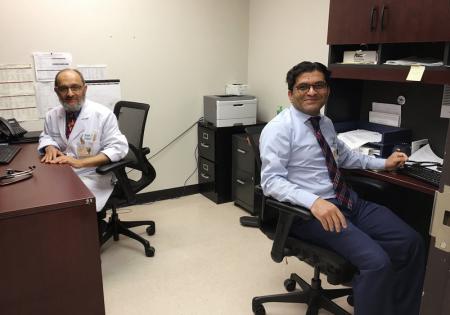HWN Jobs
- MEDICAL RECORD OFFICER II JOBS AT FEDERAL UNIVERSITY KASHERE GOMBE STATE
- INSTITUTE OF HUMAN VIROLOGY (21 POSITIONS) JOBS
- CLINTON HEALTH ACCESS INITIATIVE (2016 CHAI) JOBS
- KROWN HOSPITAL JOBS
- SUBOL HOSPITAL JOBS
HWN Blogs
- Classical heart healthy foods on HWN BLOGS
- Classical Warning Signs When The Human Liver Begins To Fail on HWN BLOGS
- Myths About Hygiene, Soaps, Germs, Sweat and Smell on HWN BLOGS
- Hernia does not heal on its own on HWN BLOGS
- Classical Essential Oils That Improves Focus Cum Memory on HWN BLOGS
news - The Uncertainties Cum Wobbling Fate Of Foreign Born Doctors on HWN SPOTLIGHT back to all News
The Uncertainties Cum Wobbling Fate Of Foreign Born Doctors on HWN SPOTLIGHT

Patients in Alexandria, La., were the friendliest people Dr. Muhammad Tauseef ever worked with. They'd drive long distances to see him, and often bring gifts.
It's a small town, so they will sometimes bring you chickens, bring you eggs, bring you homemade cakes, he says.
One woman even brought him a puppy.
That was really nice, he says.
Tauseef was born and raised in Pakistan. After going to medical school there, he applied to come to the U.S. to train as a pediatrician.
It's a path thousands of foreign-born medical students follow every year — a path that's been around for more than half a century. And, like most foreign-born physicians, Tauseef came on a J1 visa. That meant after training he had two options: return to Pakistan or work for three years in an area the U.S. government has identified as having a provider shortage.
He chose to work with mostly uninsured kids at a pediatric practice in Alexandria. "That was a challenge," he says. "But it was rewarding as well because you are taking care of people who there aren't many to take care for.
And the U.S. medical system depends on doctors like Tauseef, says Dr. Andrew Gurman, president of the American Medical Association. He worries that if President Trump's executive order on immigration takes effect, it will mean parts of the country that desperately need medical care may not have a doctor.
International medical graduates have been a resource to provide medical care to areas that don't otherwise have access to physicians, he says. "With the current uncertainty about those physicians' immigration status, we don't know whether or not these areas are going to receive care.
According to the AMA, today there are about 280,000 international medical graduates in the U.S. That's about 1 in 4 doctors practicing here. Some are U.S. citizens who've gone abroad for medical school, but most aren't.
They don't all have permanent visas, and so a lot of them are concerned about what their status is going to be, whether they can stay, whether they can go home to visit family and still come back, and the communities they serve have similar questions, he says.
And the care provided by the graduates of foreign medical schools is, by and large, top notch. A study published Feb. 3 in the journal The BMJ, formerly The British Medical Journal, shows Medicare patients treated by doctors with degrees from non-U.S. medical schools get just as good care — and sometimes better — than those treated by graduates of American medical schools.
The immigration uncertainty is hitting medical schools at a tough time. Dr. Salahuddin Kazi is in charge of recruiting top students from across the world for the University of Texas Southwestern residency program.
Typically we have 3,000 people applying for our 61 positions — of those 3,000, at least half of them are international medical graduates, he says.
Applicants find out their program match in March and usually start working in June. That gives them about 90 days to get a visa. Kazi worries this year that won't be long enough and that students from countries included in the travel ban won't be admitted.
That would create hardship for the hospital, for us and for our remaining residents, he says. They'll have to pick up more shifts or give up vacation.
Pediatrician Tauseef left Louisiana two years ago but continues to care for low-income patients at Los Barrios Unidos Community Clinic in Dallas. Six of the 30 physicians who work at this clinic are from other countries.
Tauseef says they're all educated to do the same thing. As a physician, being a foreign medical graduate, U.S. medical graduate, a Muslim doctor, a non-Muslim, we are trained to look for signs and symptoms, he says. We do not look at anybody's color; we are not trained to look at anybody's religion or ethnicity.
Tauseef, who has been in America for 13 years, says he will apply for U.S. citizenship in March.
Source: NPR, HWN AFRICA.
: 2017-02-13 19:11:07 | : 2576
HWN News
- First Polish infant to survive on extreme dialysis on HWN MEDICAL MIRACLES
- Drug resistant tuberculosis end game on HWN INSIGHTS
- Too many women opting for caesarean sections (CS) to give birth on HWN SEX EDU
- The intelligent, strong and fearless Nurse that conquered Ebola on HWN ARCHIVE
- Medhi Benatia, down with injury on HWN SPORTS






